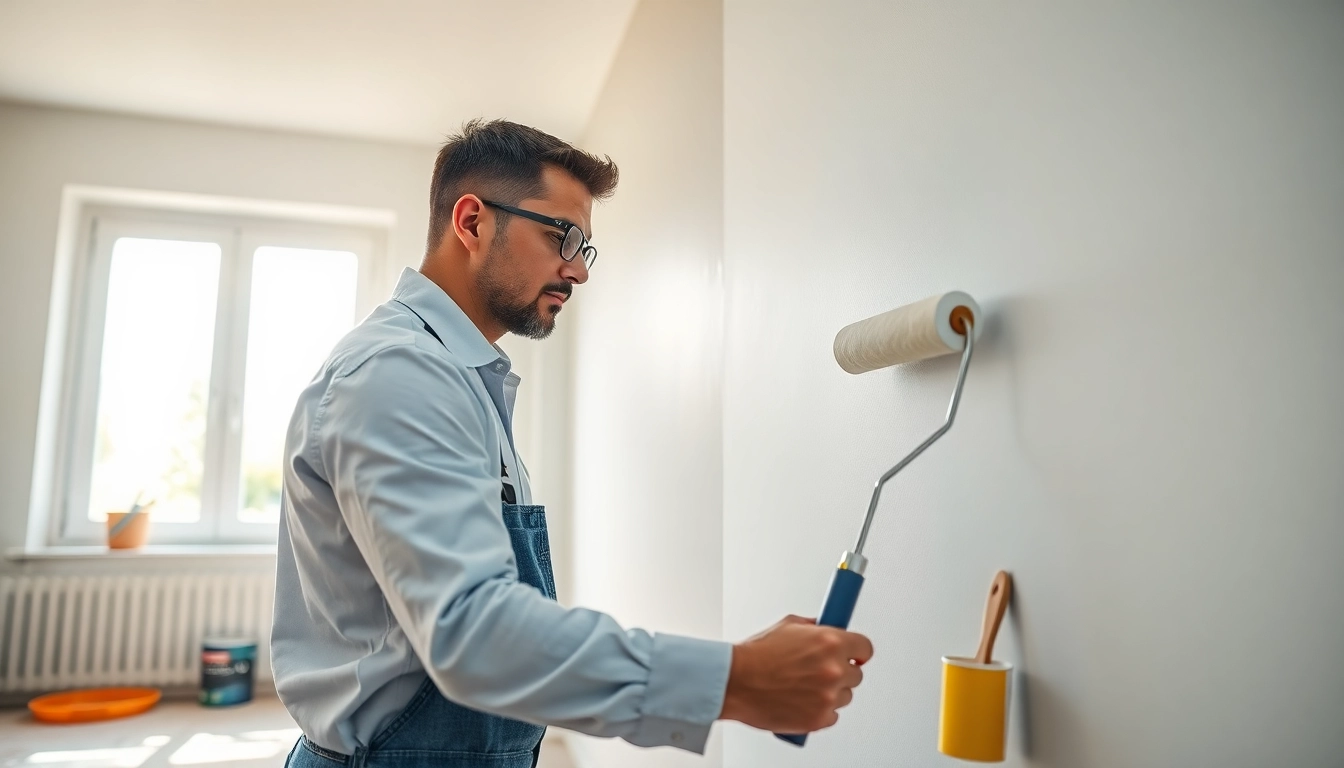Understanding Drywall Painting Basics
Drywall painting is a crucial aspect of interior home design, providing aesthetic appeal and a protective layer to your walls. Whether you are upgrading your living space or preparing for a new construction project, understanding the fundamentals of drywall painting is essential. In this guide, we will delve deep into both the techniques and its significance, ensuring you are equipped to achieve a flawless finish.
What is Drywall Painting?
At its core, drywall painting involves applying paint to drywall surfaces, which typically serve as walls or ceilings in homes and buildings. Drywall, made from a combination of gypsum plaster and paper, forms a smooth surface that is ideal for various paint applications. Painting drywall not only enhances visual appeal but also helps to seal the surface from moisture and prevents the material from appearing dingy over time.
Different techniques and products are necessary depending on whether the drywall is newly installed or being repainted. New drywall might require additional steps, such as priming and sanding, to ensure the paint adheres correctly and results in an even finish.
Materials Needed for Successful Drywall Painting
Proper preparation and the right materials are fundamental for successful drywall painting. Some of the essential materials include:
- Drywall Primer: This is essential for sealing the porous surface of new drywall before applying paint.
- Quality Paint: Choose quality paint specifically designed for drywall, such as latex or acrylic paints. The finish (matte, satin, or glossy) will depend on the desired effect and the specific room conditions.
- Paint Roller and Brushes: Different tools allow for better coverage and precision, especially in tricky areas like corners.
- Sandpaper: Used for smoothing out any imperfections in the drywall before painting.
- Drop Cloths and Painter’s Tape: These protect floors and adjacent surfaces from paint splatters and allow for clean edges.
Common Mistakes in Drywall Painting
Even experienced painters can make errors that detract from the finish quality. Some common mistakes include:
- Not Priming: Skipping primer can lead to uneven paint coverage and poor adhesion.
- Poor Surface Preparation: Failing to clean, sand, or repair surfaces can result in a blotchy appearance.
- Using the Wrong Tools: Using improper brushes or rollers can create streaks or lint residue on the finished walls.
- Inadequate Drying Time: Not allowing sufficient time for primer and paint to dry can cause issues, from peeling to uneven textures.
Preparing Drywall for Painting
Cleaning and Sanding Surfaces
Preparation is the cornerstone of a successful painting project. Start by cleaning the drywall surfaces with a vacuum or damp cloth to remove dust. After cleaning, inspect the surface for any imperfections, such as dents or holes. Using a joint compound, fill in these imperfections and allow the compound to dry completely before sanding.
Use a fine-grit sandpaper to smooth out the surface, making it as flat and uniform as possible. Pay special attention to areas around joints and fasteners, as these are prone to creating bumps if not adequately sanded.
Applying Primer: Why It Matters
Applying primer is a critical step that should never be overlooked. Primer serves several functions: it seals the drywall, creates a uniform surface for the paint, and enhances adhesion. Additionally, primer helps to prevent the topcoat from absorbing unevenly into the drywall, which can cause color inconsistencies, especially when dealing with lighter paint shades.
Generally, it’s recommended to apply at least one coat of primer on new drywall. If you’re painting over previously painted drywall, assess the current condition of the paint. If it’s in good condition, a good cleaning may suffice; if there’s old texture or staining, applying primer is advisable.
Choosing the Right Paint for Drywall
The choice of paint can significantly affect the final outcome of your drywall painting project. For interiors, latex paint is preferred due to its easy cleanup and low odor. Here are a few critical considerations:
- Finish: Different finishes serve different aesthetics and practical needs. Flat finishes hide imperfections but may be less durable, while satin and eggshell finishes offer easy cleaning options.
- Color: Lighter colors can make spaces feel larger, while darker shades create a cozy atmosphere. Consider the room’s purpose when selecting paint color.
- Type: For kitchens and bathrooms, high-gloss or semi-gloss paints can withstand moisture, whereas living rooms might benefit from flat or satin finishes.
Step-by-Step Techniques for Drywall Painting
Essential Tools and Equipment
Using the right tools can make the painting process smoother and result in a better finish. Here are some essential tools you will need:
- Paint Roller: Ideal for covering large areas quickly and effectively.
- Paint Brush: Necessary for detailed work on edges and corners where a roller won’t reach.
- Paint Tray: Holds your paint, making it easier to load your brush or roller.
- Ladder: Helps reach high areas, ensuring that you can paint every section of your wall.
- Masking Tape: Prevents paint from getting onto trim, windows, or adjacent walls.
Mastering the Roller and Brush Technique
When it comes to applying paint, technique is key. Begin with the edges and corners using a brush. Once complete, move on to the roller for the large wall sections. To do this effectively:
- Dip the roller into the paint tray, ensuring it is well-covered without being drippy.
- Start rolling from the top of the wall down, using a “W” or zigzag pattern to distribute the paint evenly.
- Follow up with horizontal strokes to maintain a consistent thickness and to blend areas seamlessly.
Dealing with Edges and Corners
Edges and corners often require special attention to ensure a clean look. Use painter’s tape around trim or adjacent walls to prevent paint bleed. For corners, a small brush or corner roller is beneficial for navigating tight spaces. Always maintain a steady hand and work slowly to avoid spills or drips.
Advanced Tips for a Professional Finish
Sanding Between Coats: Is It Necessary?
Sanding between coats of paint isn’t mandatory but highly recommended for achieving a professional smooth finish. When you lightly sand each coat after it dries, you create a better surface for the next coat to adhere to, which helps to eliminate imperfections that may have formed.
Using Different Paint Finishes Effectively
Understanding the impact of paint finishes can transform your walls. Flat finishes are great for hiding flaws, while glossy finishes concatenate light and color, making spaces appear brighter. Experimenting with different finishes can enhance layered aesthetic effects and influence the mood of each room.
Applying Texture for Enhanced Aesthetics
Textures can add depth and character to your walls. Techniques such as sponge painting or applying a stucco finish are popular choices. However, ensure that textures do not overpower the paint color; they should complement rather than detract from the overall design. Consider testing a small area before committing to a larger section.
Post-Painting Care and Maintenance
Understanding Curing Time and Conditions
After painting, understanding curing time is essential. While the paint may feel dry to touch within hours, it may take up to several weeks to fully cure. Ensure proper ventilation in the painted area and consider the humidity and temperature of the room as these factors can impact curing.
Cleaning Up After Drywall Painting
Once the painting is complete, cleaning up effectively is vital. Remove painter’s tape while the paint is slightly tacky to achieve sharp lines. Store any leftover paint properly for future touch-ups and wash brushes and rollers in warm soapy water immediately to extend their lifespan.
Maintenance Tips for Painted Drywall
Maintaining painted drywall involves regular inspections for stains, scuffs, or signs of wear. Minor scuffs can often be wiped clean, while stubborn stains may require touch-up paint. It’s best to touch up areas with the same paint application method to ensure consistency in texture and finish.
By mastering the art of drywall painting, you not only enhance the beauty of your home but also ensure its longevity. This comprehensive guide equips you with the skills and knowledge necessary to tackle any drywall painting project with confidence.



